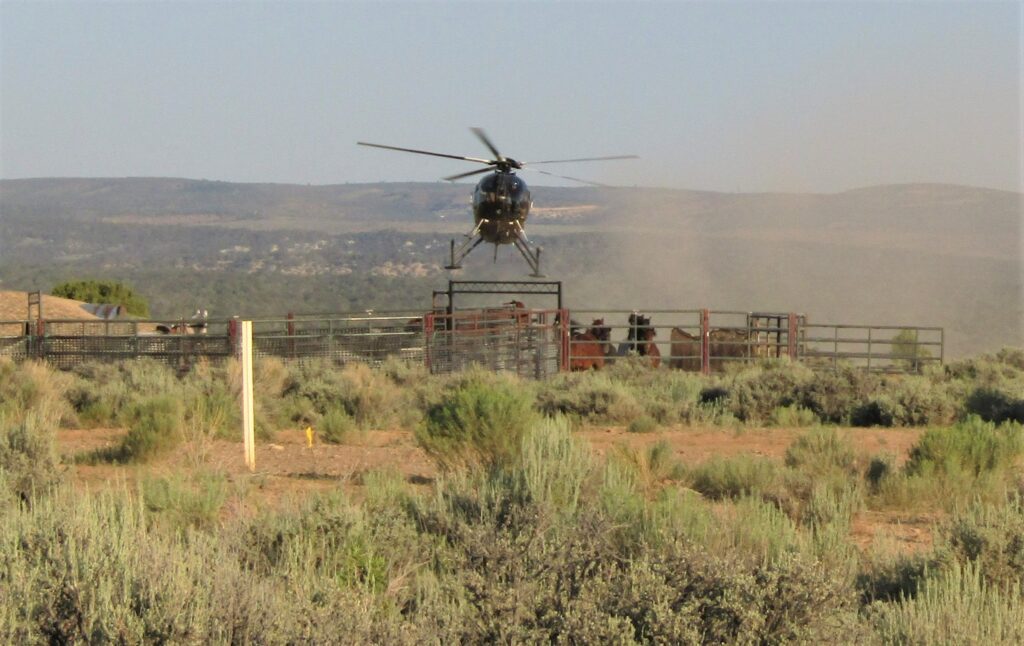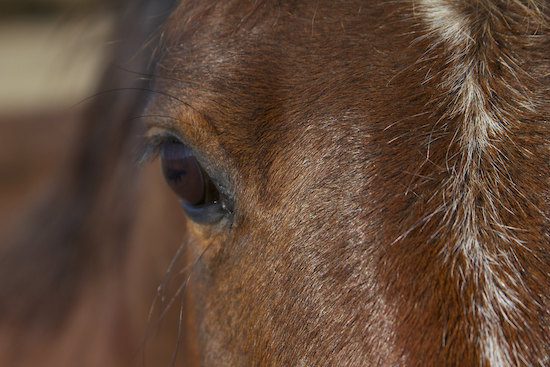


The Bureau of Land Management is misleading the American people about the nation’s wild horses and burros.
By Ginger Fedak, Independent Media Institute
6 min read
Every year, thousands of wild horses and burros are chased by helicopters and ripped from their native land in terrifyingly brutal, and often deadly, roundups. After capture, they are corralled in crowded dry lot holding pens, where many contract diseases or injuries and some then die or are killed. Some of the captured wild horses and burros are adopted out or sold to questionable buyers. Many of these horses are in turn sold to slaughterhouses. These horrendous actions are perpetrated by the U.S. government while using taxpayer dollars to protect the vested interests of cattle and sheep ranchers.
The Department of the Interior’s Bureau of Land Management (BLM) is the government agency responsible for “managing” public lands and the wild equids who live on them. It practices cruel and egregious methods of removing wild free-roaming horses and burros from public lands, even though these lands have been set aside by law for their “principal use.”
The roundups are physically tortuous and indiscriminate. Young, old, and heavily pregnant mustangs are forced into a violent stampede over rocky and dangerous terrain. Low-flying helicopters chase the terrified horses into traps. Young animals collapse in exhaustion or are rendered helpless from injury as they run in fear for their lives. Spontaneous abortions and stillbirths can occur among pregnant mares. Bonded family bands are shattered in the chaos marking the end of their freedom.
Many of these federally protected wild horses are eventually shipped to the killing floor of horse slaughterhouses in Mexico or Canada. The federal protections afforded to these horses in the U.S. are stripped as soon as they become the property of a buyer or adopter with the transfer of title from another country.
The unanimously passed Wild Free-Roaming Horses and Burros Act of 1971 was meant to protect these “living symbols of historic and pioneer spirit of the West.” Yet, instead, the government seems more interested in protecting the interests of cattle and sheep ranchers. Wild horses and burros are scapegoated by private ranchers for the degradation of public lands caused by their own exploited livestock. Ranchers blame the wild equids so that these absurdly unnecessary roundups will leave more resources for their private use. After wild horses are rounded up, more cattle and sheep are put on the public land.

Many Americans might be disturbed by the plight of wild horses and burros on our public lands for various reasons. Not only are helicopter roundups inhumane and deadly, but they are also costly to American taxpayers. Every year several millions of taxpayer dollars are paid to helicopter contractors and private holding facility contracts. If that wasn’t bad enough, many more millions are lost in the subsidized grazing leases that corporate ranchers insidiously benefit from.
The BLM acknowledges that public land livestock grazing leads to the loss of millions of dollars every year. Corporate ranchers currently pay only $1.35 per animal unit month (AUM). An AUM is the amount of forage that would be consumed by one cow-calf pair, or five sheep in one month. Meanwhile, the average going rate for grazing leases on private land is about $22.60 per AUM. This constitutes a taxpayer subsidy of approximately $21 for feeding every cow-calf pair per month. During the 2015 fiscal year, the BLM’s grazing program lost $22 million, without even counting the costs of other management activities. The agency spent $36 million on administration costs for the grazing program, while only bringing in $15 million in grazing fees.
Many United States citizens might say that the country needs to subsidize these livestock ranching operations to provide affordable meat products for Americans. However, while more and more Americans are including plant-based proteins in their diets, large taxpayer-subsidized livestock operations are selling the vast majority of their product to foreign markets where meat prices are much higher. There is no economic sense to be found in a grazing program that destroys our public lands to ensure profits for the large corporate ranchers selling meat abroad while losing millions of dollars of taxpayers’ money every year.
It has been widely proven in scientific studies and research by various government agencies that cattle and sheep are highly destructive to public lands due to the grazing practices private ranchers use. Cattle and sheep are non-native species to North America, who came from moist, humid climates in Europe and elsewhere. They are not suited for arid and semi-arid landscapes. A 1977 report by the U.S. Government Accounting Office (GAO) titled “Public Rangelands Continue to Deteriorate” stated, “The Nation’s public rangelands have been deteriorating for years and, for the most part, are not improving. Deterioration can be attributed principally to poorly managed livestock grazing.” Even though the report was a scathing rebuke of the BLM’s policies, which allowed the overgrazing of public lands, and called for additional and updated management plans, little has been done in the 45 years since this report was published. Required management plans are sorely lacking.
Conversely, wild horses are a native species to North America because they evolved on this continent, beginning 55 million years ago. Over the millennia, they evolved on this continent from a small deerlike figure to what we now see as the modern horse. They are well suited to the climate and topography of the Western states.
We should also be concerned because livestock contributes significantly to global warming and the climate crisis. The digestive systems of wild horses and burros do not contribute to greenhouse gases. According to a 2006 report by the Food and Agriculture Organization of the United Nations, “Cattle-rearing generates more global warming greenhouse gases, as measured in CO2 equivalent, than transportation.”
Wild horses and burros have also been shown to improve their habitat and range. Their simple digestive tracts allow whole seeds to be deposited in their manure whereas cows’ four-stomach system destroys any ability to reseed the land. Wild equids can also help the land in other ways, such as naturally maintaining grass and brush at safer levels and acting as a mitigation to potential wildfire occurrences, thus saving lives and millions or even billions of dollars in destruction.
With all the positive effects that wild horses and burros have on public lands, their contributions to local economies from wild horse viewing eco-tourism and photography, and their beloved status among American citizens and people all over the world, why are they then so harassed and mismanaged by the BLM? Especially when it is costing taxpayers hundreds of millions of dollars.
Sadly, the livestock and extractive industries have a stranglehold on the BLM and Congress. Taxpayer subsidies enrich these private companies allowing them to make political contributions to maintain their influence. Backed by big Ag, gas, oil, and mining, the BLM scapegoats wild horses instead of removing ranchers whose cattle and sheep degrade the land and vastly outnumber horses; often by 30 to 1 in many places. Disinformation and carefully selected partial information are fed to the American public in a profuse propaganda campaign. This is done to purposely present misleading information to justify “emergency” roundups in many wild horse herd areas, including the world-famous Onaqui and Sand Wash Basin herds in Utah and Colorado, respectively. This propaganda campaign seems to be continuing.
Now the BLM is claiming that the herd from Colorado’s Piceance-East Douglas Herd Management Area must be drastically reduced due to the health of the horses and the rangeland. With prolific amounts of photographic evidence and testimonials to the contrary, the BLM ignores it all and has forged ahead with the roundup. Despite evidence showing these horses and their range are in good condition and calls from the public and political figures to stop this roundup, the agency moved forward with its plans. It is Colorado’s largest roundup to date. The BLM removed more than 800 horses, dangerously running them down with helicopters during the hottest days of summer.
###
Ginger Fedak is the wild horse and burro campaign director at In Defense of Animals. A lifelong animal welfare advocate and horse professional, Fedak has spent decades teaching about and advocating for domestic and wild horses.
Take action…

America’s wild horses and burros deserve justice
The Bureau of Land Management’s (BLM) wild horse and burro program has recently come under fire due to the extraordinarily large number of wild horse deaths occurring at its Cañon City holding facility. Experienced advocates know, however, that these kinds of deaths are nothing new. For decades, wild horses and burros have been suffering and dying under this inhumane “management” system.
The plight of wild horses and burros is rapidly worsening because the BLM has become more empowered by getting away with its misinformation campaigns and deceitful practices. The purposeful misrepresentation of facts from the BLM to the American public, media, and Congress is disgraceful. The agency refuses to take responsibility for its monumental failures and consistently changes the narrative to place the blame elsewhere.
What can we Americans do to help wild horses and burros and the planet? We can continue to call and write to our congressional legislators and advocate for truth, science, and our wild equids.
Urge your federal legislators to order a full and independent investigation leading to the overhaul of the Bureau of Land Management’s wild horse and burro program.
Parting thought…

“If all the beasts were gone, men would die from great loneliness of spirit, for whatever happens to the beasts also happens to man.” —Chief Seattle
Earth | Food | Life (EFL) explores the critical and often interconnected issues facing the climate/environment, food/agriculture and nature/animal rights, and champions action; specifically, how responsible citizens, voters and consumers can help put society on an ethical path of sustainability that respects the rights of all species who call this planet home. EFL emphasizes the idea that everything is connected, so every decision matters.
Click here to support the work of EFL and the Independent Media Institute.
Questions, comments, suggestions, submissions? Contact EFL editor Reynard Loki at [email protected]. Follow EFL on Twitter @EarthFoodLife.
